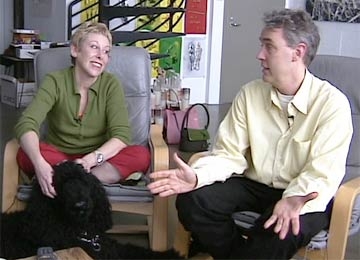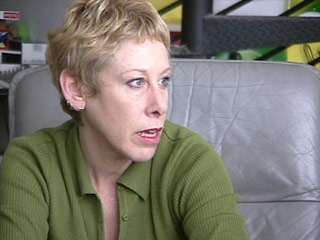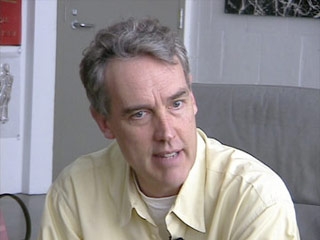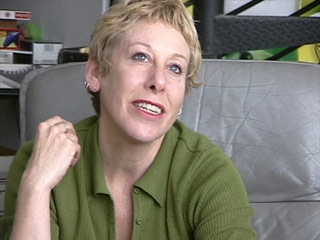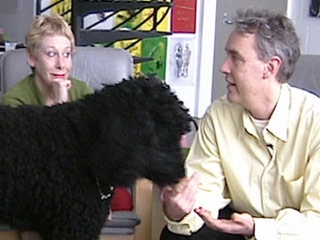Feature: Conversations
Sabina Ott and Mark Johnson
Part II: Surviving as an Artist
The painters Mark Johnson and Sabina Ott first met in the 1970s when they were classmates at the San Francisco Art Institute. Johnson is now the Gallery Director at San Francisco State University; Ott returned to SFAI this past year as the Director of Graduate Studies. They saw each other for the first time in two decades when Stretcher brought them together to talk about painting and art education. In Part I, they shared their impressions on art education and the state of painting today. We pick up the conversation as their thoughts turned to artistic survival strategies.
Meredith Tromble
Mark Johnson Sabina was a founder of Jetwave, the most exciting alternative space in town at the time it happened.
Sabina Ott I don’t know if we were the most exciting. But we were one of the first ones. We got an NEA grant which we didn’t use - we sent it back which completely ruined our reputation. You don’t get one and send it back.
Stretcher Why did you do that?
SO Because we were ruffians and why should we fill out all these forms? Just give us the money. We were quite appalled that it came attached with obligations. It was good to not be responsible to government agencies—I think that’s one of the downfalls of alternative spaces. They get conservative because they have fear of no funding. The work they show is watered-down and compromised. Not the work maybe, but the presentation of the work, with didactic panels talking to people like they’re two years old. They do it because they feel they have to and maybe they do have to, to get their funding. But if you have people in showing work in their apartments, that’s much more exciting and costs nothing. It can be whatever the person’s vision is.
MJ There was a wonderful painter from Moscow who showed her slides here. They were in grave economic difficulties there, but once a year, they moved their entire life into a tiny corner of their space and covered it with a tarp for a month, then made a spectacular show in their apartment. They made huge painted installations, and because they had total access to the space, they could go way overboard. We have to reinvent that mentality, because of the collapse of art centers after the dot-com explosion sent real estate prices up. Even though real estate prices are starting to go down, penny on the dollar it’s still unaffordable compared to what it was in the 1970s.
SO At the time, San Francisco was in a terrible economic slump, which was fabulous for us because it felt like the whole City was your studio. There’s a moment of change that happens when people are in complete economic nothingness. It’s open territory.
MJ I do disagree with one thing you said. There is tremendous conservatism related to grants, but I don’t believe that one of the manifestations of that is didactic wall text. I work in a context where most of the people are not art people. San Francisco State University has 30,000 students and an art department of roughly 600 or 700 students. It’s tiny when you compare it to the university as a whole, so most of the people who come into the gallery don’t know what to expect. It’s an interesting opportunity to teach people about art.
SO I think that can be well done. But I just came here from St. Louis, a hotbed of conservatism like a lot of the Midwestern cities. They don’t think they’re conservative, particularly – they think they’re normal. But art is easily disturbing so people who are very into the arts sometimes have an impulse to explain the stuff away. My pet peeve is this underestimating of what people call “the general public.” I think the general public is smart and knows exactly what they’re looking at. But you are right that there are clues, hard information, that need to be given. We’re talking about two different things.
MJ How are you planning to handle the new curatorial studies program you’re putting together at SFAI?
SO Most art historians are taught that the best people to work with are dead people. Their training doesn’t intersect with current studio practice at all. But we’re making our future curators take studio art. We’re hoping that some of the MFA art students will go into the curatorial studies program, because artists have to take their own venues into their own hands. Once you start blurring those boundaries, it gets dangerous. You start messing with who makes history and who doesn’t. What if artists did? That’s really a powerful thing. Or what if the curators see themselves as artists? Messing up those categories is important.
MJ That’s exciting. We all have to take responsibility constantly for putting our work out there. An art work is kind of completed when it’s seen. I’ve been teaching for a while, and one of the most demoralizing experiences for me is to encounter former students who, in the past, had a lot of energy. But they’ve burned out, and become depressed and resentful, because no one is looking at their work. I think art practice includes putting it out there, even if it’s in cafes or apartment shows. Every week figure out how to find some kind of venue to show your work. Use alternatives if the standard venues are not interested. I’ve always been inspired by the folks who just nail it up on the street. It makes such a difference to my experience of walking up and down the street.
Stretcher How do you as educators talk to students about the fact that even artists who have had a certain measure of success may not have material success in comparison to successful people in other fields? I have a good friend who has been fairly successful, yet she’s bitter. She thinks maybe the twenty years she spent as an artist wasn’t the best use of her time.
SO We have to evolve with our culture, expand our ideas of what art making is. Is your art practice just making a painting in a locked-up studio? And if so, yes, you are archaic and good-bye, go learn computer skills and get a job because you’ll never make it. I’m serious. I think this is a different world and permeability is necessary. Curating is art practice. Playing with my dog is art practice. We’ve been learning about this since the ‘50s, from forebears like Allen Kaprow. Art is life. Nobody really believes that who only has a studio practice. But just having a studio practice doesn’t work any more and I think it’s good that it doesn’t. Post-studio practice is important. If artists stick to old categories, how is anybody else supposed to change them?
Stretcher It might help students avoid depression ten years down the road if they understood that the art world around us – the schools, the museums — was created by artists who were active here fifty, sixty, one hundred years ago. Their impact is still felt. Their names aren’t in history books, but their energy continues to make a difference to people.
MJ There are all kinds of ways of participating in the art world.
SO When I was in the Midwest, I used to tell people that it was their job as artists to look better than they were looking. They should dress better because that was a good form of aesthetic. There’s also the alternative space conversation. I often hear generalized conversations about reaching other communities, by which everybody means communities of color. But the information systems particular to those communities are never researched. I mentioned this to Fred Wilson and he said, "Well, you know no one ever asked me" and I said, "Well okay, what?" And he goes, "Radio." Radio and barber shops and shopping malls — that’s where people get information. All across the country, to the African American community, radio is it. TV, too, but radio is easy. Our fine arts fliers, ads, and newspapers don’t do it. There’s a huge Asian population here. So why aren’t there art posters in Chinese? And who has computers and who doesn’t? A lot of people do, but what communities don’t?
Stretcher What do you tell your students about the challenges they’ll face after graduate school? How do you keep the fire burning?
SO It’s easier when you’re in a place where there aren’t huge expectations. New Zealand is a tiny place, with a huge art school population relative to the size of the entire population. Yet somehow artists sustain their stuff. There’s no expectation of an international career; they work. I found three boutiques in different cities there with the hippest clothes — really great stuff — they were run practicing artists who had these boutiques for money.
MJ That reminds of Deborah Iyall.
SO She had that band….[Romeo Void]
MJ She was such an important part of her community here. She also did the Ink Clan, a group of Native American printmakers at the South of Market Cultural Center. Then I heard that her apartment had doubled in price and she moved to the Southern California desert. I ran into her recently, because she was up here doing a play. I asked her how it was going, and she said “I’m having a ball. Unlike living in the Bay Area, where we’re all really competing and trying to keep a toehold, I’m enjoying a lot of success where I am now and I’m artist in residence at several community centers. I’m doing tons of teaching and I have so much more going on now.” It’s interesting to think about working in other communities that aren’t saturated with artists.
SO That’s what it means to expand your notion of living as an artist.

